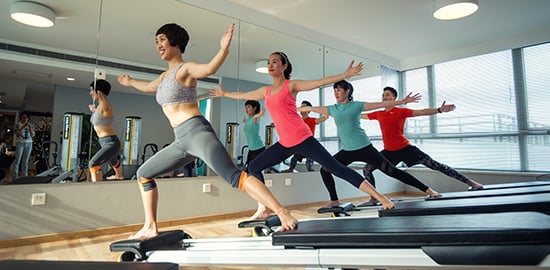World-first Deakin study pinpoints best exercises to beat back pain
Media release
Active treatments including Pilates, stabilisation exercises, weight training and aerobic exercise could be the most effective to help beat chronic low back pain, according to new research from Deakin's Institute for Physical Activity and Nutrition (IPAN).
The world-first analysis, published today in the British Journal of Sports Medicine, compared 89 studies that examined a range of back pain treatments. It found that moving the body beats passive treatment or rest, and pinpointed the types of exercise that lead to the best outcomes for different back pain symptoms.
Lead researcher IPAN Associate Professor Daniel Belavy said the study showed the most effective exercises to improve pain, physical function and mental health were:
- Resistance exercise, using weight machines or free weights at increasing loads to build strength;
- Pilates;
- Stabilisation or motor control exercise training, which focusses on training specific muscles; and
- Aerobic exercise training, such as walking or cycling.
"There was evidence that Pilates and stabilisation or motor control exercise training were the best of these exercises for reducing pain," Associate Professor Belavy said.
"The least likely treatments to be effective included hands-off treatment, such as only educating people about chronic pain or doing psychological interventions alone, and hands-on treatment, like manual therapy, massage and acupuncture.
"Importantly, stretching and McKenzie exercises, which is a treatment approach that uses a classification system to prescribe exercise, were found to be the least effective kinds of exercises."
Associate Professor Daniel Belavy said spinal pain represented the greatest cost to Australian society of any disease in terms of disability and lost productivity.
"Low back pain affects 80 to 90 per cent of Australians in their lifetime and while the majority of spinal pain cases resolve without specific intervention, it's chronic or persistent low back pain that presents the greatest challenge," Associate Professor Belavy said.
"In the vast majority of chronic low back pain cases the pain is 'non-specific' meaning that clinicians cannot define a specific diagnosis, or cause, of the pain."
Associate Professor Belavy said there was an increasing body of evidence that showed active treatments were the most effective way to relieve the symptoms of chronic low back pain, compared to passive treatments.
"Researchers and clinicians have believed for some time now that exercise is beneficial for low back pain, however nobody has been able to demonstrate which exercise is more beneficial than another," he said.
"We sought to address this by implementing an analytical procedure called 'network meta-analysis' which enabled us to compare two treatments across a network of studies, even if a single study has not directly compared both. This allowed us to look at data from 5578 patients across 89 different studies, building up a better picture of effective interventions."
But Associate Professor Belavy said it was unlikely that one kind of exercise training was the single best approach to treating non-specific chronic low back pain.
"Rather, our study provides evidence that active therapies where the patient is guided, actively encouraged to move and exercise in a progressive fashion are the most effective," he said.
"There is a common misconception that if someone is in pain, they should be resting, but our research shows that when the pain has been there for a long time, exercise is an important part of treatment.
"Active exercise where the person is taken though a structured program to regain confidence with their body and movement can help reduce pain."
This project was funded by Musculoskeletal Australia.
Owen PJ, Miller CT, Mundell NL, Verswijveren SJJM, Tagliaferri S, Brisby H, Bowe S, Belavy DL (2019) Which specific modes of exercise training are most effective for treating low back pain? Network meta-analysis. British Journal of Sports Medicine. DOI: 10.1136/bjsports-2019-100886

